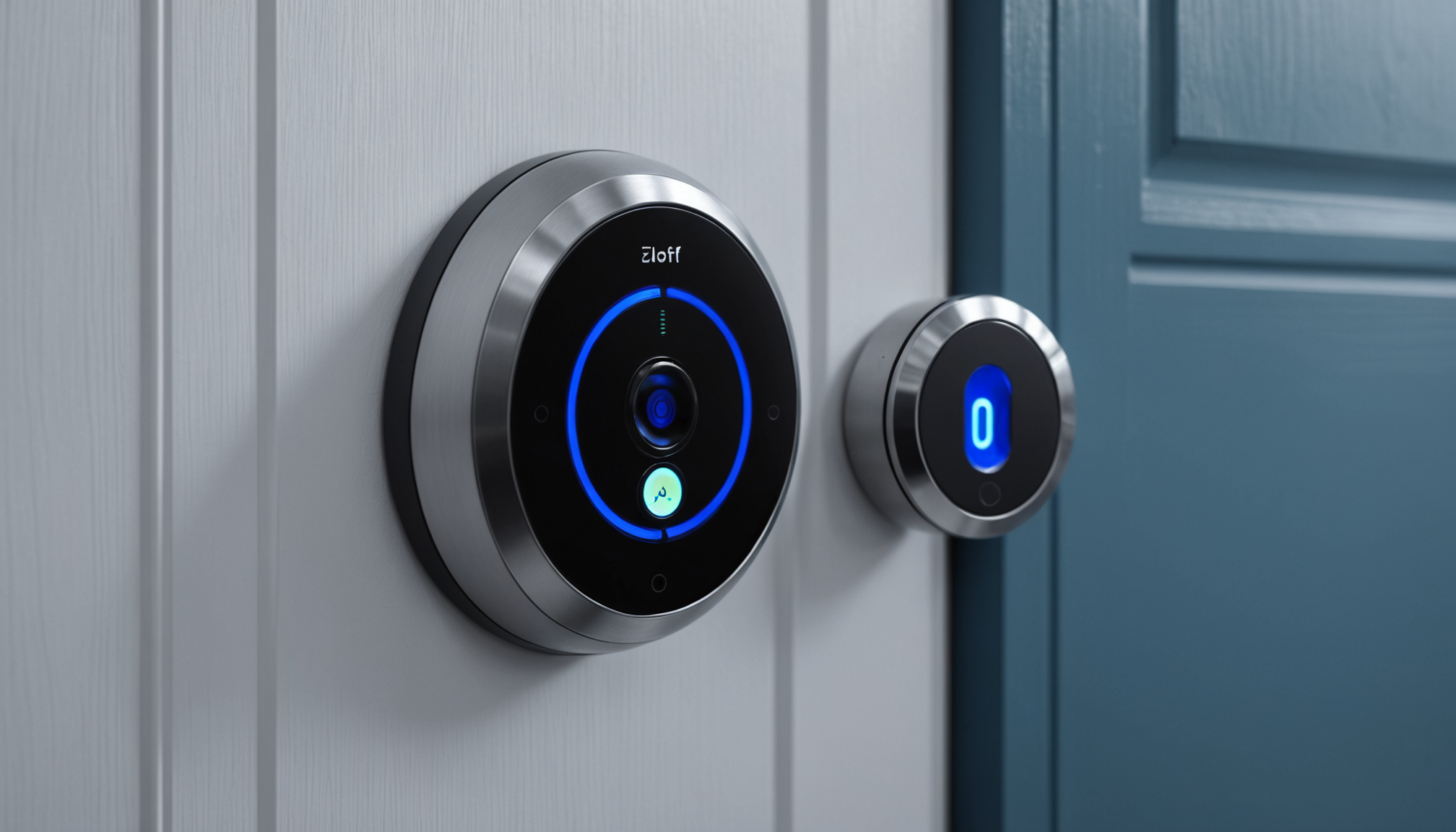As technology continues to evolve, the realm of home security has seen significant advancements that make traditional lock and key mechanisms seem outdated. At the forefront of these innovations for 2025 are smart locks and digital keys, which offer enhanced security features, convenience, and integration capabilities that cater to the demands of modern homeowners.
Smart locks are quickly becoming a staple in home security upgrades, providing an array of features that enhance both functionality and security. Unlike conventional locks, smart locks operate electronically and can be controlled and monitored via smartphone apps, remote controls, or voice commands. This not only adds a layer of convenience but also allows homeowners to manage access to their homes with greater flexibility and oversight.
One of the major benefits of smart locks is the ability to issue digital keys to family members, friends, or service providers. These digital keys can be configured to grant access for specific periods, track who enters and exits, and can be easily revoked or reissued without the need for physical key exchanges. This is particularly useful for households with multiple inhabitants or for those who frequently host guests or service personnel.
Furthermore, smart locks are equipped with advanced encryption technologies to ensure that only authorized users can gain entry. Many of these devices now integrate biometric authentication methods, such as fingerprint scanning or facial recognition, providing an additional layer of security that makes unauthorized access considerably more difficult. Integration with other smart home systems, such as video doorbells and surveillance cameras, further enhances the security ecosystem by allowing homeowners to verify identities and monitor entry points in real-time.
To illustrate the advantages of smart locks over traditional locking systems, consider the following comparison:
| Smart Locks | Traditional Locks | |
| Access Control | Remote and programmable digital keys, biometric access | Physical keys only |
| Security Features | Encryption, multi-factor authentication, real-time alerts | Basic mechanical mechanisms |
| Convenience | Keyless entry, remote locking/unlocking, smart home integration | Manual locking/unlocking, physical key dependency |
| Cost | Higher initial investment with potential long-term savings | Lower initial cost, higher long-term security risks |
This juxtaposition highlights the significant improvements smart locks offer in terms of convenience and comprehensive home security management. As the adoption of such systems becomes more prevalent, we can expect them to play an increasingly important role in safeguarding homes.
With the rapid technological advancements in smart lock systems, homeowners now have more tools at their disposal to enhance security and enjoy greater peace of mind. As part of a more interconnected digital ecosystem, these devices not only offer practical benefits but also mark a decisive step forward in the evolution of home security solutions.
Advanced surveillance systems
 As technology continues to evolve, one of the standout advancements in home security is the development of sophisticated surveillance systems. These systems are essential for modern security setups, providing real-time monitoring and comprehensive coverage of your property to ensure peace of mind.
As technology continues to evolve, one of the standout advancements in home security is the development of sophisticated surveillance systems. These systems are essential for modern security setups, providing real-time monitoring and comprehensive coverage of your property to ensure peace of mind.
To implement or upgrade to an advanced surveillance system for your home, follow these steps:
- Assess Your Security Needs: Begin by evaluating the specific security requirements of your property. Consider the size, layout, and any vulnerable entry points that might be susceptible to intrusion. Identify areas that require constant surveillance, such as entrances, driveways, and backyard spaces.
- Select the Right Cameras: Choose cameras that meet your needs. Modern options include HD quality, night vision, and wide-angle lenses. Opt for cameras with motion detection capabilities and weather resistance, particularly if they are to be installed outdoors. Consider whether you need wired or wireless systems, as each has its own advantages.
- Integration with Smart Home Systems: Ensure your surveillance system can integrate with existing smart home platforms. Compatibility with apps that offer real-time video monitoring and cloud storage allows for easier access and management of recorded footage.
- Professional Installation vs. DIY: Decide between professional installation and a do-it-yourself approach. Professional installation guarantees optimal camera placement and system calibration, though it may come at a higher cost. DIY installations can be more affordable, but ensure you follow guidelines for best practices in camera positioning.
- Use of AI and Analytics: Advanced surveillance systems now incorporate AI technology to analyze footage in real-time, identifying potential security threats automatically. These systems can differentiate between pets, vehicles, and people to reduce false alarms and ensure relevant alerts.
- Storage and Data Management: Decide on the storage model that fits your needs. Options include local storage, cloud storage, or hybrid systems. Cloud storage may offer greater accessibility and redundancy, while local systems can provide more control over your data.
- Regular Maintenance and Updates: Regularly maintain your surveillance system by cleaning camera lenses, checking battery levels for wireless cameras, and ensuring firmware is up to date. Scheduled system tests can identify potential failures or needs for camera repositioning.
- Legal and Privacy Considerations: Be aware of local regulations regarding surveillance. Ensure cameras are not intruding into neighboring properties and that family, guests, or employees are informed of surveillance when appropriate.
Installing an advanced surveillance system not only enhances security but also serves as a deterrent against potential intruders. By selecting the appropriate components and leveraging state-of-the-art technologies, homeowners can significantly bolster their property’s defense mechanisms, leading to safer living environments.
Automated lighting and blinds
 In the realm of modern home security, one of the less obvious yet highly effective upgrades involves automated lighting and blinds systems. These innovations go beyond simple convenience, playing a crucial role in enhancing home security by simulating occupancy and controlling visibility into the home environment.
In the realm of modern home security, one of the less obvious yet highly effective upgrades involves automated lighting and blinds systems. These innovations go beyond simple convenience, playing a crucial role in enhancing home security by simulating occupancy and controlling visibility into the home environment.
When it comes to automated lighting, the ability to control lights remotely or set them on a programmable schedule can give the impression that someone is at home, even when the house is empty. This simulation of occupancy is a powerful deterrent for potential burglars, who often target homes that appear vacant. Smart lights can be programmed to mimic natural human patterns—turning on in the evening and off at bedtime, for example—or they can be set to trigger based on sunset and sunrise times, adapting automatically to seasonal changes. Such features introduce a dynamic protective element that traditional lighting cannot offer, creating a living illusion that keeps intruders at bay.
Moreover, integrating these lights with a smart home system allows for responsive, real-time control. Whether you’re at work or on vacation, an app or a voice command lets you adjust the lighting scenario instantly. The connection to motion detectors or door sensors can further enhance security, activating lights throughout the home when unusual movement is detected, potentially startling an intruder and drawing attention to their presence.
Alongside lighting, automated blinds contribute significantly to home security. By controlling visibility both inside and outside the home, they help protect privacy and prevent outsiders from discerning whether the house is occupied. Smart blinds can be programmed to open and close at certain times, or they can be adjusted remotely through a smartphone app. Some advanced systems even use sunlight sensors to determine when to open or close, maximizing energy efficiency alongside enhanced privacy.
The integration of automated lighting and blinds with security systems also plays a role in energy management. By careful scheduling and responsive control, these systems can reduce the waste of electricity, offering a dual benefit of increased security and decreased energy costs.
In an era where AI and IoT technologies are on the rise, the ability of these systems to analyze user patterns and adapt accordingly further adds to their appeal. For instance, learning behaviors over time allows these automated systems to refine their actions, optimizing both security and efficiency as they anticipate user needs.
By embracing automated lighting and blinds, homeowners are not only adopting a cutting-edge approach to home management but are also significantly enhancing their property’s security posture. Offering a blend of protection, privacy, and efficiency, these systems form an integral part of the sophisticated safety net desired in contemporary residences.
Enhanced motion detection
 As we delve into the realm of motion detection, recent advancements have revolutionized how homeowners can safeguard their properties. Enhanced motion detection systems for 2025 are far more sophisticated than their predecessors, capable of differentiating between benign movements and potential threats, thereby redefining the landscape of home security.
As we delve into the realm of motion detection, recent advancements have revolutionized how homeowners can safeguard their properties. Enhanced motion detection systems for 2025 are far more sophisticated than their predecessors, capable of differentiating between benign movements and potential threats, thereby redefining the landscape of home security.
At the core of these enhanced systems is an improved layer of sensitivity and intelligence. Modern motion detectors utilize a combination of infrared, microwave, and ultrasonic technologies to accurately detect movement. This multipronged approach ensures that even the slightest unauthorized movements are detected while minimizing false alarms caused by pets, swaying trees, or passing vehicles. The integration of these technologies offers a greater degree of precision in monitoring, enabling homeowners to feel confident in the security coverage their systems provide.
Moreover, today’s motion detectors are increasingly AI-driven, providing not only detection but also analysis of motion events. Artificial intelligence algorithms are now advanced enough to process the intricacies of human movement versus other figures, which allows for smarter alerts and responses. Homeowners can program these systems to recognize the regular comings and goings of family members and the abnormal presence of unknown individuals, further refining the ability to detect real threats versus everyday activities.
Another key feature of these systems is their interactivity with other smart home devices. Enhanced motion detectors can seamlessly integrate with lighting, alarms, and surveillance cameras, creating a synchronized security network. For example, upon motion detection, cameras can start recording automatically while lights illuminate the detected area, providing clear visibility and reducing the likelihood of intruder success. This interconnectedness heightens the deterrence factor and elevates overall home safety.
Installation convenience has also been addressed in newer models, which often come in wireless configurations, allowing for easy set-up and mobility. This flexibility means they can be repositioned as needed or moved to new locations entirely, a feature that provides adaptable security as the needs of a household evolve.
The adaptability of these systems extends to customization options, whereby users can set specific parameters for alert notifications. Whether via smartphone alerts, integrated home assistant notifications, or through security service providers, the homeowner remains informed of any suspicious activity in real-time, no matter their location.
Finally, the advent of sustainability within these systems aligns with current environmental trends. Many models now offer energy-efficient designs, using low power when not actively engaged in detection or being powered by renewable energy sources such as solar panels. This reduces energy consumption and costs, making them a more environmentally friendly and cost-effective option for continuous home protection.
As household security continues to become more sophisticated, enhanced motion detection systems stand out as key players by offering precision, adaptability, and comprehensive integration capabilities, thus embodying the future of proactive home defense.
AI-driven security management
 In recent years, AI-driven security management systems have become a cornerstone of modern home security by seamlessly integrating artificial intelligence into the safety framework of homes. These systems leverage advanced algorithms and data analytics to predict and respond to potential security threats autonomously, providing a proactive approach to home defense. One of the primary benefits is the system’s ability to learn and adapt to the specific security needs of a household. By analyzing patterns of activity through connected devices and sensors, AI-driven systems can anticipate potential security breaches and alert homeowners in real time, thereby enhancing real-time threat detection.
In recent years, AI-driven security management systems have become a cornerstone of modern home security by seamlessly integrating artificial intelligence into the safety framework of homes. These systems leverage advanced algorithms and data analytics to predict and respond to potential security threats autonomously, providing a proactive approach to home defense. One of the primary benefits is the system’s ability to learn and adapt to the specific security needs of a household. By analyzing patterns of activity through connected devices and sensors, AI-driven systems can anticipate potential security breaches and alert homeowners in real time, thereby enhancing real-time threat detection.
A particularly revolutionary feature of AI-driven security systems is their ability to integrate with other smart home devices. This integration provides a cohesive security network that can take automatic measures in response to detected threats. For instance, upon identifying unusual activity, the system might initiate lockdown protocols, engage surveillance cameras, or activate alarm systems, creating multiple layers of protection without requiring direct human intervention. Furthermore, voice recognition technology integrated with AI security management allows for seamless interaction and control, enabling homeowners to manage their systems effortlessly.
Moreover, these systems offer comprehensive data privacy and protection measures. Utilizing encryption and cybersecurity protocols, AI-driven security management ensures that personal data remains secure from cyber threats, thus alleviating concerns about potential data breaches or misuse. The ability of AI to discern actual threats from false positives minimizes unnecessary alerts, reducing homeowner anxiety and improving response efficiency.
As AI technology continues to evolve, expect to see even greater personalization and precision in security management. Systems can become increasingly intuitive, offering customized security solutions that cater to individual lifestyle needs. With the potential incorporation of machine learning features, these systems will continue to enhance their understanding of human behavior patterns, adjusting security measures accordingly to provide dynamic and adaptive protection.
In summary, as these futuristic technologies converge into a holistic security ecosystem, AI-driven security management represents the cutting edge of home security upgrades. Beyond mere threat detection, these systems promise to revolutionize the way we think about home safety, offering unparalleled protection, convenience, and peace of mind for homeowners. By embracing these advanced technologies, homeowners can ensure their homes are equipped to handle the security challenges of 2025 and beyond.

